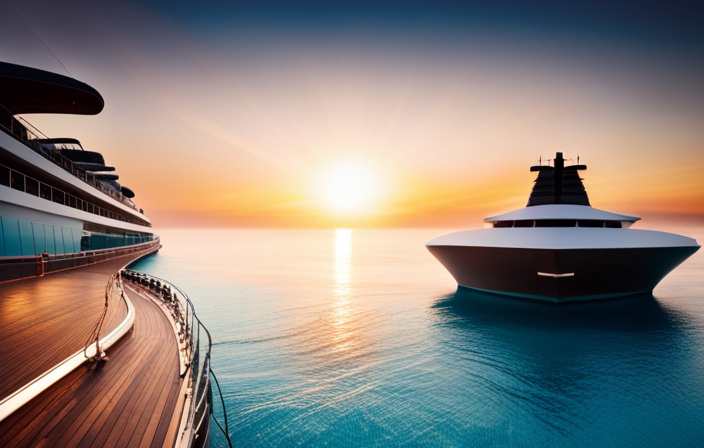As soon as I stepped off the cruise ship and onto solid ground, I was overwhelmed by a peculiar sensation. It felt like the constant swaying of the ocean had seeped into my very being, causing me to stagger and sway with each step I took. Ah, the infamous sea legs. This phenomenon is something that many people encounter after spending time at sea.
Intrigued by this peculiar bodily adjustment, I delved into the depths of research to uncover the truth behind sea legs. How long do they truly last? Is there a way to alleviate this unsteady feeling? And what myths surround this phenomenon?
In this article, I will explore the duration of sea legs, providing you with objective and detailed information. I will also share tips to alleviate this discomfort and debunk common misconceptions about sea legs. Furthermore, I will include personal stories of those who have experienced it firsthand, as well as its portrayal in popular culture.
So, join me on this journey as we navigate the aftermath of a cruise and embrace the fascinating world of sea legs.
Key Takeaways
- Sea legs can last for a few days to a week, but some individuals may experience persistent symptoms.
- Symptoms of sea legs include disorientation, dizziness, and nausea, and are caused by the brain struggling to adapt to sensory changes.
- Seek medical advice if symptoms persist, as healthcare professionals can provide evaluation and treatment options, including medications and balance exercises.
- Activities promoting stability, such as small walks and focusing on a fixed point, can help alleviate sea legs symptoms.
What are Sea Legs?
Once you disembark from the cruise ship, it takes some time for your body’s equilibrium to readjust and for sea legs to subside. Sea legs refer to the sensation of still being on the rocking ship even after getting off. This condition is caused by the body’s vestibular system, which regulates balance, being accustomed to the constant motion at sea. As a result, when you step onto solid ground, your brain still perceives movement, leading to dizziness and unsteadiness.
To help regain your balance, it’s recommended to focus on a fixed point, avoid sudden movements, and take it slow when walking. Additionally, maintaining a healthy diet and staying hydrated can aid in reducing the symptoms of sea legs. Understanding the causes of sea legs will further assist in managing this post-cruise sensation.
Causes of Sea Legs
As soon as you step off the ship, your land legs may take some time to readjust and get used to the stable ground again. The causes of sea legs can be attributed to the effects of motion sickness, which can lead to dizziness and a sense of imbalance. Motion sickness occurs when there is a conflict between the visual signals received by the eyes and the sensory signals received by the inner ear. This conflict can result in feelings of nausea, dizziness, and disorientation. To better understand the effects of motion sickness, take a look at the table below:
| Symptoms of Motion Sickness | Common Causes |
|---|---|
| Nausea | Uneven terrain |
| Dizziness | Rapid movements |
| Disorientation | Visual stimuli |
As your body adjusts to the stable ground, the duration of sea legs will gradually decrease. Transitioning into the subsequent section, it is important to understand how long sea legs last after a cruise.
Duration of Sea Legs
When you step off the ship, your body may still feel like it’s swaying on the ocean waves, taking a moment to adjust to the steady ground beneath your feet. Sea legs, also known as mal de debarquement syndrome, can last anywhere from a few hours to several days.
The duration of sea legs varies from person to person, depending on factors such as individual susceptibility, the length of the cruise, and the intensity of the motion experienced. While there’s no specific recovery time for sea legs, there are exercises that can help alleviate the symptoms. These exercises include focusing on a stationary object, practicing balance exercises, and gradually reintroducing movement.
By engaging in these exercises, individuals can speed up the recovery process and regain their land legs more quickly. Transitioning into the subsequent section about tips to alleviate sea legs, it’s important to note that there are various methods that can help ease the discomfort caused by sea legs.
Tips to Alleviate Sea Legs
If you’re feeling a bit wobbly after disembarking from the ship, here are some tips to help you regain your land legs and alleviate the discomfort.
-
Take it Slow: Allow yourself time to adjust to being on solid ground again. Avoid sudden movements and take small steps to maintain balance.
-
Stay Hydrated: Drink plenty of water to prevent dehydration, which can worsen dizziness.
-
Focus on a Fixed Point: Find a stationary object and fix your gaze on it to help stabilize your equilibrium.
-
Perform Balance Exercises: Engage in exercises such as standing on one leg or practicing tai chi to improve your balance.
By following these tips for reducing dizziness and incorporating exercises for balance improvement, you can expedite the recovery process and minimize the duration of your sea legs.
Transitioning into the subsequent section about the prevention of sea legs, it’s important to take proactive measures before embarking on a cruise to ensure a smoother transition back to land.
Prevention of Sea Legs
To prevent feeling wobbly after getting off the ship, it’s crucial to take proactive measures before setting sail, ensuring a smoother transition back to solid ground.
Prevention tips for sea legs include staying hydrated throughout the cruise, as dehydration can exacerbate symptoms. It’s also important to maintain a balanced diet and avoid excessive alcohol consumption, as both can contribute to an unsettled stomach.
Engaging in regular exercise and physical activities before and during the cruise can help strengthen your muscles and improve your balance, reducing the likelihood of experiencing sea legs. Additionally, some travelers find relief in wearing acupressure wristbands or taking over-the-counter motion sickness medication.
By following these prevention strategies, you can increase your chances of enjoying a seamless return to land after your cruise.
Transitioning into coping with sea legs in everyday life, it’s important to continue implementing these strategies to minimize any lingering effects.
Coping with Sea Legs in Everyday Life
When coping with sea legs in everyday life, there are a few key points to keep in mind.
First, gradual re-adaptation is important to allow your body to adjust back to being on land.
It’s also important to minimize activities that can trigger symptoms, such as sudden movements or being in crowded spaces.
Finally, if symptoms persist or become severe, it’s advisable to seek medical advice to ensure there aren’t any underlying issues causing the prolonged sea legs.
Gradual Re-Adaptation
During this gradual re-adaptation period, your sea legs may linger longer than expected, reminding you of the profound impact that the ocean has on your body and soul.
The recovery process after a cruise involves various physical adjustments as your body adjusts to being back on land. Your inner ear, which plays a crucial role in maintaining balance, needs time to readjust to stable ground. This can result in feelings of dizziness and unsteadiness, commonly known as sea legs.
Additionally, your muscles and joints may need time to recover from the constant motion experienced at sea. It’s important to be patient during this re-adaptation phase and to gradually resume your regular activities. Minimizing activities that trigger symptoms, such as sudden movements or excessive exertion, can help ease the transition and hasten the return to normalcy.
Minimize Activities that Trigger Symptoms
One way to hasten the return to normalcy after a cruise is by minimizing activities that trigger symptoms. It is important to be mindful of activities that may exacerbate the discomfort associated with sea legs.
Walking on uneven surfaces or participating in vigorous exercise can prolong the post-cruise recovery process. It is recommended to engage in gentle activities that promote balance and stability, such as light stretching or yoga. Taking breaks and resting when needed can also minimize discomfort.
Additionally, avoiding activities that involve sudden movements or changes in position, like jumping or bending over, can help alleviate symptoms. By being cautious and mindful of these triggers, the recovery period can be shortened, allowing for a smoother transition back to solid ground.
Seeking medical advice if symptoms persist is crucial for proper evaluation and treatment.
Seek Medical Advice if Symptoms Persist
If your symptoms continue, it’s important to seek medical advice for a proper evaluation and treatment. While sea legs typically go away on their own within a few days to a week after a cruise, some individuals may experience persistent symptoms. Seeking medical advice is crucial to determine if there are any underlying medical conditions or long-term effects associated with sea legs.
A healthcare professional can provide a thorough evaluation and recommend appropriate treatment options. They may suggest medications to alleviate symptoms or provide exercises and techniques to help retrain your body’s balance system. Remember, everyone’s experience with sea legs is different, and seeking medical advice is the best way to ensure you receive the care you need.
Moving on to common myths about sea legs, let’s address some misconceptions that people often have.
Common Myths about Sea Legs
Sea legs only affect novice cruisers, as experienced sailors have developed their sea legs and are less likely to experience the symptoms.
Sea legs are a psychological phenomenon, where the brain and body need time to adjust to the motion of the ship.
While there’s no instant cure for sea legs, there are methods such as walking and focusing on a fixed point that can help alleviate the symptoms.
Sea Legs Only Affect Novice Cruisers
Typically, the lingering effects of sea legs tend to trouble those who are new to the world of ocean cruises. However, it’s important to note that sea legs can affect both novice and experienced cruisers alike. While seasoned travelers may have developed strategies to cope with the sensation, they’re not immune to the sway and motion of the ship.
As the vessel navigates the open waters, the constant rocking can disrupt one’s sense of balance, leading to the infamous sea legs. For those who have been on numerous cruises, the duration of sea legs may be shorter, as their bodies have adapted to the motion over time. Nevertheless, even experienced cruisers may experience some residual effects for a day or two after disembarking.
This transition into the subsequent section emphasizes that sea legs are not just a physical response but also a psychological phenomenon.
Sea Legs are a Psychological Phenomenon
When you step off the ship, your mind may still be swaying, a reminder of the profound psychological impact of sea legs. Sea legs, commonly experienced by novice cruisers, are not simply a physical phenomenon, but also a psychological one. The causes of imbalance are rooted in the body’s attempt to readjust to stable ground after being on a moving vessel for an extended period of time. This adjustment can take anywhere from a few hours to a few days, depending on the individual. During this time, individuals may experience a sense of disorientation, dizziness, and even nausea. The psychological effects of sea legs can be attributed to the brain’s struggle to adapt to the sudden change in sensory input. It takes time for the mind to recalibrate and regain its equilibrium. However, sea legs can be cured instantly by engaging in activities that promote stability and balance. Transitioning into the subsequent section, it is important to note that sea legs can be overcome without taking a step.
Sea Legs Can Be Cured Instantly
The mind can quickly regain its stability, like a top spinning smoothly on a tabletop, by engaging in activities that promote balance and stability. When it comes to sea legs, there’s an instant cure that provides immediate relief from the discomfort. Here are four activities that can help alleviate sea legs:
-
Walking on solid ground: Taking a walk on stable ground can help recalibrate the body and restore a sense of balance.
-
Focusing on a fixed point: By fixing your gaze on a stationary object, such as a distant tree or building, you can help retrain your brain to adjust to stable surroundings.
-
Performing simple balance exercises: Standing on one leg or practicing yoga poses that require balance can help strengthen the muscles and restore equilibrium.
-
Getting a good night’s sleep: Resting and allowing your body to recover can significantly reduce the duration of sea legs.
By engaging in these activities, you can find relief from sea legs and get back to enjoying your land-based adventures. Transitioning into the subsequent section about personal stories of sea legs, it’s fascinating to hear how others have experienced this phenomenon.
Personal Stories of Sea Legs
As I stepped off the cruise ship and onto solid ground, I couldn’t help but feel a slight wobble in my legs, a lingering reminder of my sea legs. It took a few minutes for the sensation to fade away completely, but I was relieved to be back on stable land.
Talking to fellow passengers, I realized that I wasn’t the only one experiencing this peculiar sensation. Many shared their personal anecdotes of sea legs lasting for a few hours or even a couple of days after disembarking from a cruise. Some offered tips for managing sea legs, such as taking small, frequent walks and staying hydrated.
It’s fascinating how our bodies adapt to the constant motion of a ship and then readjust to being on land. Transitioning from sea legs to the portrayal of sea legs in popular culture, it’s interesting to see how this phenomenon has been depicted in movies and literature.
Sea Legs in Popular Culture
After sharing personal stories of sea legs, it’s interesting to explore how sea legs are portrayed in popular culture.
Movies and literature often depict the aftereffects of being on a cruise, showcasing the realities of sea legs. In movies like ‘Titanic’ and ‘The Perfect Storm,’ we see characters struggling to regain their balance and adjust to stable ground after being at sea for an extended period. Similarly, in literature, authors like Ernest Hemingway and Herman Melville vividly describe the physical and psychological effects of sea legs on their characters.
The portrayal of sea legs in popular culture adds depth and authenticity to the overall cruise experience. It allows us to empathize with the characters and understand the challenges they face during their journey.
Transitioning into the conclusion, it’s important to embrace the aftermath of a cruise and appreciate the unique experience it offers.
Conclusion: Embracing the Aftermath of a Cruise
So let’s kick back, relax, and savor the post-cruise vibe, embracing the delightful aftermath of our seafaring adventure. After spending days or even weeks on a cruise ship, it’s natural to feel a bit disoriented when we step back onto solid ground.
This phenomenon, commonly known as sea legs, can last anywhere from a few hours to a few days, depending on the individual. During this time, our body and mind adjust to the absence of constant motion and the stability of land. It’s important to take it easy during this period, allowing ourselves to gradually get back into the rhythm of life on land.
Embracing the post-cruise experiences means enjoying the memories, sharing stories with friends and family, and cherishing the relaxation we gained from our time at sea. Adjusting to life on land may take a little time, but it’s all part of the journey.
Frequently Asked Questions
Can sea legs last longer than the duration of a cruise?
Sea legs can last longer than the duration of a cruise. The long-term effects of sea legs can vary, but symptoms typically persist for a few days to a week after disembarking from the ship.
Are there any medical treatments available to help alleviate sea legs?
Medical remedies, such as over-the-counter medications like meclizine, can help alleviate sea legs by reducing symptoms of dizziness and nausea. However, natural remedies like ginger or acupressure bands may also provide relief for some individuals.
Can children experience sea legs after a cruise?
Children can experience sea legs after a cruise. It is a common phenomenon where their bodies adjust to the motion of the ship. The duration of sea legs varies from person to person.
Are there any specific exercises or stretches that can help with sea legs?
Exercising and stretching can effectively alleviate sea legs. Engaging in gentle movements like walking, yoga, and calf raises helps improve balance and stability. Incorporating these exercises into your routine can provide relief and restore equilibrium.
Can sea legs affect your balance and coordination in the long term?
Sea legs can impact daily activities, affecting balance and coordination in the long term. These effects are due to the inner ear, which can take time to readjust after being on a cruise.
Did The Branson Belle Dinner Cruise Cause Sea Legs to Last Longer?
Some people may experience prolonged sea legs after enjoying the Branson Belle dinner cruise length. The motion of the boat can cause a lingering sensation of swaying, especially for those with heightened sensitivity. It’s advisable to take a stroll on solid ground to help readjust and alleviate any discomfort.
Conclusion
In conclusion, sea legs can be a temporary inconvenience after a cruise, but they usually disappear within a few days. It’s important to remember that the duration of sea legs can vary from person to person, depending on various factors such as individual sensitivity and the length of the cruise.
Interestingly, studies have shown that sea legs can last up to two weeks for some people, especially those who’ve been on longer cruises. Therefore, it’s crucial to be patient and take necessary steps to alleviate the discomfort until the body fully adjusts.
Meet Asra, a talented and adventurous writer who infuses her passion for exploration into every word she writes. Asra’s love for storytelling and her insatiable curiosity about the world make her an invaluable asset to the Voyager Info team.
From a young age, Asra was drawn to the power of words and their ability to transport readers to far-off lands and magical realms. Her fascination with travel and cultures from around the globe fueled her desire to become a travel writer, and she set out on a journey to turn her dreams into reality.










